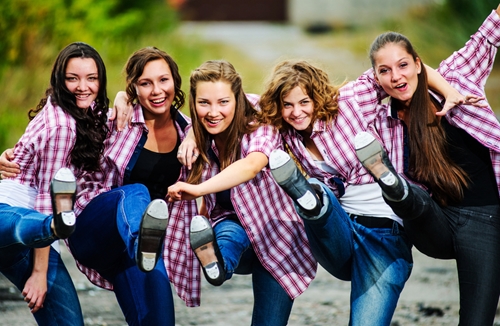Tap dance is a fun and unique art form. Unlike other dance styles that emphasize light feet and soft sounds on stage, tap dancers strive to make their feet heard. In fact, many of the moves in tap are based on intentionally creating different sound patterns. Picking the right tap dance music makes all the difference!
With the right accompaniment, tap shoes can complement the music and create a dazzling visual and audio display. The key is to find an upbeat and energetic soundtrack for your dance class that can keep your students amped up and moving!
The musical genres you choose can be tailored to your own tastes. Tap goes well with a wide range of musical styles, and has a history with each of them. Here are a few suggestions for finding the right tap dance music for your classes:
1. Jazz, Swing, Bebop
Good for: Dance history lessons
Tap dancing and jazz music have made a fantastic pairing for decades. Though tap has its roots in dances that date back centuries, Theater Dance reported that the modern notion of tap dance started to become a part of pop culture in the 1920s. This was around the same time that jazz music became more popular with mainstream crowds as well. The soulful rhythms of fast-paced jazz numbers complemented the movements and sounds of energetic tappers when they went out dancing. Dances that were all the rage at the time, like the Charleston, were often adapted for tap dancers. The era saw some overlap between tap dance music and swing, so this could also be an opportunity to incorporate some of those elements into your lessons.
By the 1940s, bebop emerged as a subgenre of jazz music. Bebop included a number of upbeat, iconic classics that are fun to tap along to.
Try: “It Don’t Mean a Thing (If it Ain’t Got That Swing)” by Duke Ellington, “Jumpin’ Jive” by Cab Calloway and the Nicholas Brothers
2. Musicals
Good for: Life imitating art
Many musicals throughout the years in film and on the stage have featured legendary tap numbers. Teaching students some of the famous tap routines they may have seen on screen before (or modified versions of them) can be a fun project that keeps the whole class focus and engaged. Choose from your own favorite films and share the routines that you fell in love with, or pick from a published list of popular dance numbers, like this one from Buzzfeed.
Try: “Singing in the Rain” from Singing in the Rain, “It’s a Hard Knock Life” from Annie
3. Today’s Hits
Good for: Appealing to your audience
Sometimes, students get more excited about dance when they know and love the songs you play. Browse through some of the Top 40 hits and find something that you’d enjoy playing with your class, or take suggestions of the students’ favorite tracks. Chances are good the dancers sing along to these songs whenever the come on the radio and dance around their rooms in a more freeform fashion. Teach them to bring their craft and their favorite tunes together for a fun and upbeat lesson.
Try: “Run the World (Girls)” by Beyonce, “Happy” by Pharrell Williams
4. Traditional Dances From Around the World
Good for: Exploring new styles
Variations of tap dancing can be found in many cultures throughout history and across the globe. Pick a new style and discuss its origins with your class as you try new moves to international folk songs.
Try: Flamenco from Spain, Step dancing from Ireland
Finding the Right Song
You know that with the right choreography, you can dance to almost anything. The key to picking the right tap dance music for your class is finding something that you’ll enjoy dancing along to, and hoping that your students will enjoy it, too. It’s so much easier to create routines with songs you’re excited about and want to listen to, so share your joy with your students.
Other considerations for selecting tap dance music include the moves you want to incorporate into your lesson, the age of your students and their experience levels. Make sure that whatever song you choose has a rhythm they can keep up with and appropriate lyrics. You can try to create a more collaborative program by soliciting feedback from the student on the music that’s played in class.



